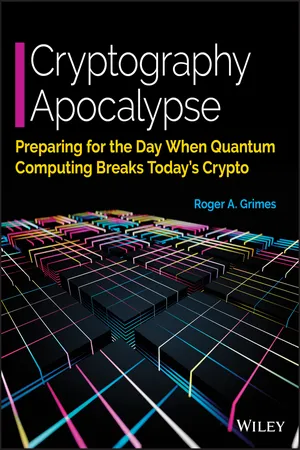
Cryptography Apocalypse
Preparing for the Day When Quantum Computing Breaks Today's Crypto
- English
- ePUB (mobile friendly)
- Available on iOS & Android
Cryptography Apocalypse
Preparing for the Day When Quantum Computing Breaks Today's Crypto
About this book
Will your organization be protected the day a quantum computer breaks encryption on the internet?
Computer encryption is vital for protecting users, data, and infrastructure in the digital age. Using traditional computing, even common desktop encryption could take decades for specialized 'crackers' to break and government and infrastructure-grade encryption would take billions of times longer. In light of these facts, it may seem that today's computer cryptography is a rock-solid way to safeguard everything from online passwords to the backbone of the entire internet. Unfortunately, many current cryptographic methods will soon be obsolete. In 2016, the National Institute of Standards and Technology (NIST) predicted that quantum computers will soon be able to break the most popular forms of public key cryptography. The encryption technologies we rely on every day—HTTPS, TLS, WiFi protection, VPNs, cryptocurrencies, PKI, digital certificates, smartcards, and most two-factor authentication—will be virtually useless... unless you prepare.
Cryptography Apocalypse is a crucial resource for every IT and InfoSec professional for preparing for the coming quantum-computing revolution. Post-quantum crypto algorithms are already a reality, but implementation will take significant time and computing power. This practical guide helps IT leaders and implementers make the appropriate decisions today to meet the challenges of tomorrow. This important book:
- Gives a simple quantum mechanics primer
- Explains how quantum computing will break current cryptography
- Offers practical advice for preparing for a post-quantum world
- Presents the latest information on new cryptographic methods
- Describes the appropriate steps leaders must take to implement existing solutions to guard against quantum-computer security threats
Cryptography Apocalypse: Preparing for the Day When Quantum Computing Breaks Today's Crypto is a must-have guide for anyone in the InfoSec world who needs to know if their security is ready for the day crypto break and how to fix it.
Frequently asked questions
- Essential is ideal for learners and professionals who enjoy exploring a wide range of subjects. Access the Essential Library with 800,000+ trusted titles and best-sellers across business, personal growth, and the humanities. Includes unlimited reading time and Standard Read Aloud voice.
- Complete: Perfect for advanced learners and researchers needing full, unrestricted access. Unlock 1.4M+ books across hundreds of subjects, including academic and specialized titles. The Complete Plan also includes advanced features like Premium Read Aloud and Research Assistant.
Please note we cannot support devices running on iOS 13 and Android 7 or earlier. Learn more about using the app.
Information
I
Quantum Computing Primer
- Chapter 1: What is Quantum?
- Chapter 2: Quantum Computers
- Chapter 3: How Can Quantum Computing Break Today’s Cryptography?
- Chapter 4: When Will the Quantum Crypto Break Happen?
- Chapter 5: What Will a Post-Quantum World Look Like?
1
Introduction to Quantum Mechanics
Those who are not shocked when they first come across quantum theory cannot possibly have understood it.Niels Bohr, quantum physicist and 1922 Nobel Prize winner
Any sufficiently advanced technology is indistinguishable from magic.Arthur C. Clarke, science-fiction author
What Is Quantum Mechanics?
Quantum Is Counterintuitive
- A single quantum particle can be in two places and be two distinctly different things at once.
- A single quantum particle can split in two and then later appear to run into or interfere with itself and recombine or cancel itself out.
- In a truly empty space with absolutely nothing (that scientists are aware of), quantum particles can just appear “out of thin air” and then vanish.
- A quantum particle will seem to behave one way when not being measured and another when being measured, as if nature absolutely cares about the action of measurement. It will seemingly even change its path or behavior back in time if you decide to measure it after it went through its original path.
- Two quantum particles can be “entangled” in such a way that when you change one, the other also instantly changes in the same way, every time, no matter how far apart they are, even across the universe.
- A quantum state is always all possible states (called a superposition of states), but the single, eventual resulting state can't be predicted with certainty.
- Every possible answer will be the answer at some point, although those answers may each be in their own separate universe. There may be a different universe for each possible combination of answer choices (called multiverses) at the atomic level.
- Star Trek–like teleportation is possible.
Quantum Mechanics Is Real
Table of contents
- Cover
- Table of Contents
- Introduction
- I: Quantum Computing Primer
- II: Preparing for the Quantum Break
- Appendix: Additional Quantum Resources
- Index
- End User License Agreement